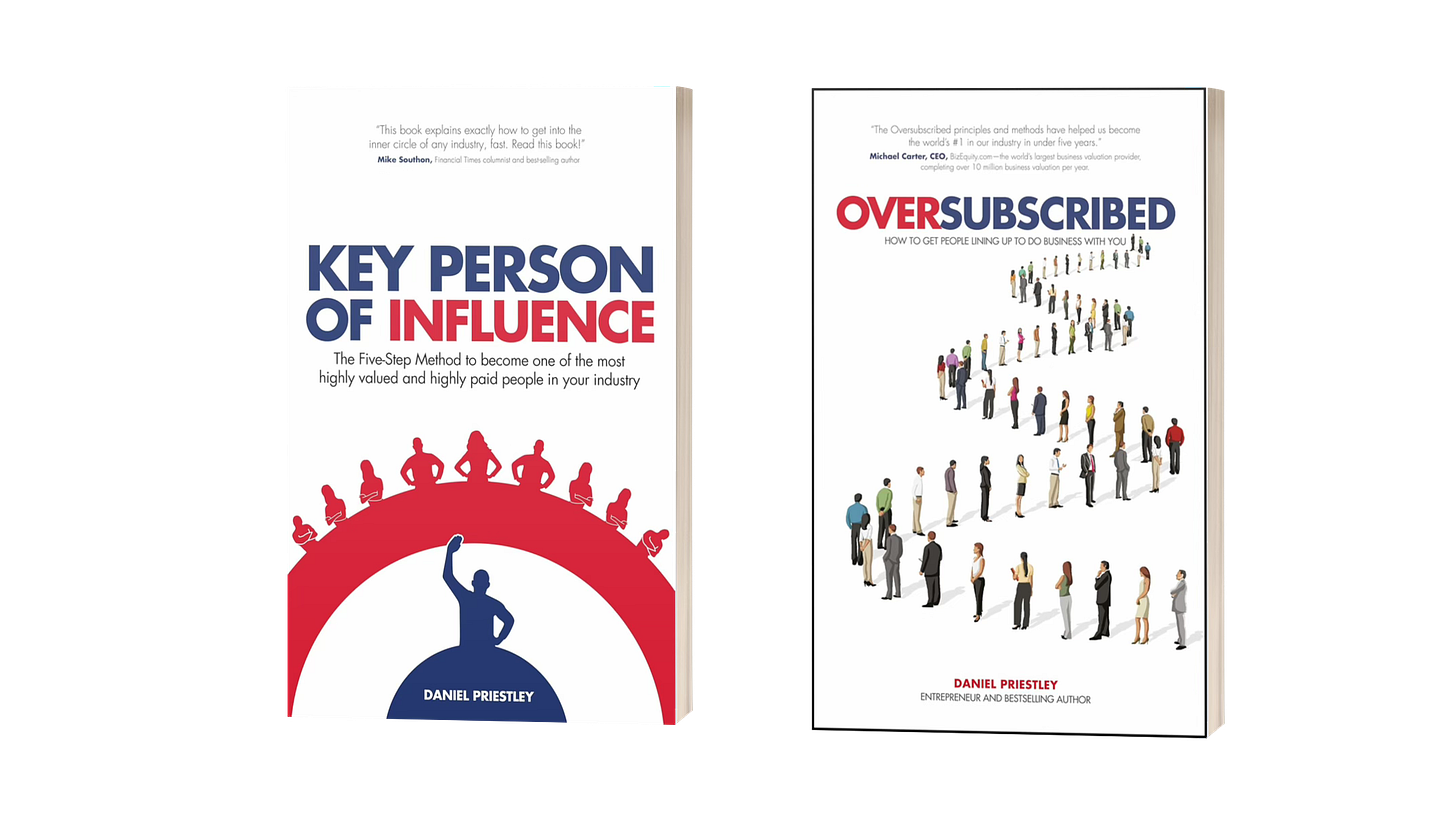10 steps to become a key person of influence and get oversubscribed 🔥
Daniel Priestley's methods to build influence and create a high-demand brand
After 30 interviews for the Millennial Masters podcast, a pattern emerged. Many of the founders I’ve spoken to credit one author and two of his books for shaping their personal brands, business strategies, and influence.
That author? Daniel Priestley.
The two books? Key Person of Influence and Oversubscribed.
Both are featured in my book of books with recommendations from Millennial Masters, How to Build Empires: 50 Books That Made Millennial Masters, where I break down five key takeaways from each. If you’re a subscriber, you’ll find a link at the bottom of this email to get the book for free.
But with so many people mentioning these books, I wanted to go further.
That’s why this week’s Booksmart isn’t focused on just one book, but two. Key Person of Influence teaches you how to position yourself as an industry leader, while Oversubscribed shows how to create so much demand that people compete to work with you.
And that’s not all: My special insights post is focused on personal branding, pulling lessons from eight of the Millennial Masters I’ve interviewed. They’re sharing both the pros and the pitfalls of building a personal brand, with practical takeaways you won’t want to miss.
Personal branding is an edge… until it isn’t 🕳️
If you’re an entrepreneur today, you’re probably building two brands: one for your business and one for yourself. But here’s the challenge: where does one end and the other begin?
Want to stand out, attract opportunities, and have people competing to work with you? Here’s how to position yourself as a key person of influence and build so much demand that your business becomes oversubscribed. 👇🏻
Millennial Masters is brought to you by Jolt ⚡️ The UK’s top web hosting service
5 steps to become a key person of influence
Daniel Priestley’s framework lays out five practical ways to build credibility, attract opportunities, and increase demand for what you do. Here’s how to start:
1️⃣ Craft a pitch that sticks
If people don’t instantly understand what you do, they won’t remember you. A strong pitch sparks interest and opens doors. Write a one-liner that captures your expertise and why it matters. Test it on 10 people this week, and if they don’t get it, tweak it.
2️⃣ Get your ideas out there
Experts share their knowledge. Whether it’s blog/newsletter posts, videos, or speaking engagements, visibility builds authority. Publish something this week. Write a LinkedIn post, record a short video, or share an industry insight on Twitter. The key is consistency, not perfection.
💡 For a deeper dive into personal branding, check out Lara Acosta’s SLAY framework for building an online presence that stands out.
3️⃣ Turn your knowledge into a product
Time is limited. Packaging your expertise into a book, course, or consulting framework lets you create impact at scale. Identify one thing you repeatedly explain or teach. Outline a simple guide, template, or mini-course and put it into action within 90 days.
4️⃣ Improve your digital presence
People look you up before they work with you. A strong online profile attracts opportunities instead of chasing them. Google yourself. If the first page doesn’t reflect your expertise, update your LinkedIn, secure guest features on industry blogs, and post valuable content regularly.
5️⃣ Build a powerful network
Influential people connect with other influential people. Partnerships open doors to collaborations, referrals, and credibility boosts. Find someone in your field whose audience overlaps with yours. Suggest a collaboration: a podcast interview, a co-branded project, or a joint event.
💡 Want to build a stronger network and create real opportunities? Keith Ferrazzi’s Never Eat Alone has the strategies you need. Check out my Book Club breakdown here:
🗣 If you’re heading to events and want to make the most of every conversation, check out my conference survival guide for strategies on networking with intent and turning connections into real opportunities.
5 steps to build an oversubscribed business
Turn demand in your favour and make people line up to work with you. Here are Daniel Priestley’s strategies to build an oversubscribed business.
1️⃣ Build demand before you sell
Most businesses launch a product and then try to sell it. Big mistake. Instead, build an audience that’s hungry for what you offer before making anything available. Create content, share insights, and generate buzz around your expertise. Get people pre-committed before you even open the doors.
2️⃣ Signal scarcity and exclusivity
People want what feels limited. Waiting lists, selective entry, and capped availability make offers more desirable. When access is restricted, those who get in act faster and value it more.
3️⃣ Warm up your audience with value
Customers rarely buy the first time they see an offer. They need to hear from you, see your content, and engage multiple times. Use emails, social media, and events to educate and connect. Priestley’s 7-11-4 rule suggests people need seven interactions, 11 minutes of engagement, and to see you in four places before they commit.
4️⃣ Make customers qualify before they buy
Not every customer is the right fit. Instead of selling to anyone, set an application process or vetting system. This shifts the dynamic, positioning your offer as something people have to earn, not just buy.
5️⃣ Keep raising the bar
Oversubscribed brands don’t rely on one-time sales. They evolve, improve, and give customers a reason to stay engaged. Whether it’s a better experience, a new version, or a fresh way to connect, innovation keeps people coming back.
👤 About the author
Daniel Priestley is a serial entrepreneur, speaker, and best-selling author known for helping business leaders stand out and create high-demand brands. With multiple successful ventures across the UK, US, and Australia, he has built multimillion-dollar companies and mentored thousands of entrepreneurs.
Read smarter, not harder 📚
📺 Can’t get enough of Daniel Priestley? Also watch:









